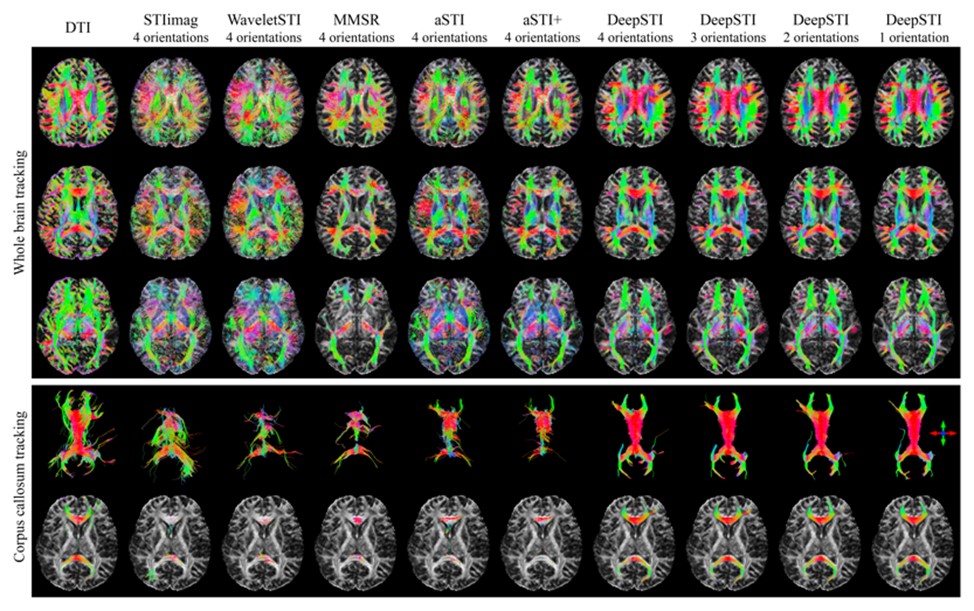The magnetic susceptibility of an MRI voxel is influenced by tissue microstructure, particularly structural anisotropy such as the aligned myelin sheaths in white matter. Susceptibility Tensor Imaging (STI) leverages this property to assess fiber orientation and connectivity in the human brain.1-3 Due to its high signal-to-noise ratio (SNR), STI holds promise for mesoscopic-resolution fiber mapping without requiring specialized hardware—offering the potential for high-resolution tractography and insights into myelin integrity using standard clinical MRI systems.
Conventional STI requires MRI data acquired at multiple head orientations to capture anisotropic susceptibility, limiting its clinical application. To address this, we have developed deep learning–based STI methods (DeepSTI, see figure)4 that reduce or eliminate the need for multiple orientations while enhancing the resolution of white matter tractography. This advancement enables STI from a single orientation at both 3T and 7T field strengths. Ongoing work aims to extend this capability to accurately resolve crossing fibers.

Figure. 1. STI-based fiber tractography results from phase measurements acquired on a healthy volunteer at 7T with 1 mm isotropic resolution in comparison to the corresponding DTI (1st column, acquired at 3T with 2.2 isotropic resolution). DeepSTI using 4, 3, 2 and 1 orientations were compared to conventional STI approaches (STIimag, WaveletSTI, MMSR, aSTI and aSTI+’s results all from 4 orientations). From Fang et. al Med Image Anal. 2023; 87:102829.
Reference:
- Liu C. Susceptibility tensor imaging. Magn Reson Med. 2010;63(6):1471-7. doi: 10.1002/mrm.22482. PubMed PMID: 20512849; PMCID: PMC2990786.
- Li X, Vikram DS, Lim IAL, Jones CK, Farrell JAD, van Zijl PCM. Mapping magnetic susceptibility anisotropies of white matter in vivo in the human brain at 7 T. NeuroImage. 2012;62(1):314-30. doi: 10.1016/j.neuroimage.2012.04.042.
- Li W, Liu C, Duong TQ, van Zijl PC, Li X. Susceptibility tensor imaging (STI) of the brain. NMR Biomed. 2017;30(4). doi: 10.1002/nbm.3540. PubMed PMID: 27120169; PMCID: PMC5083244.
- Fang Z, Lai KW, van Zijl P, Li X, Sulam J. DeepSTI: Towards tensor reconstruction using fewer orientations in susceptibility tensor imaging. Med Image Anal. 2023;87:102829. Epub 2023/05/06. doi: 10.1016/j.media.2023.102829. PubMed PMID: 37146440.
